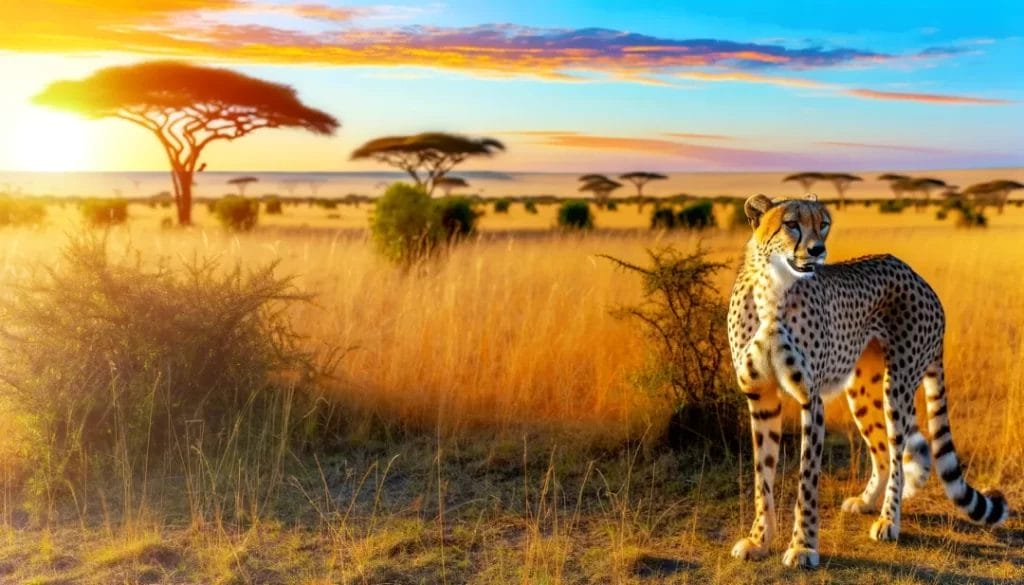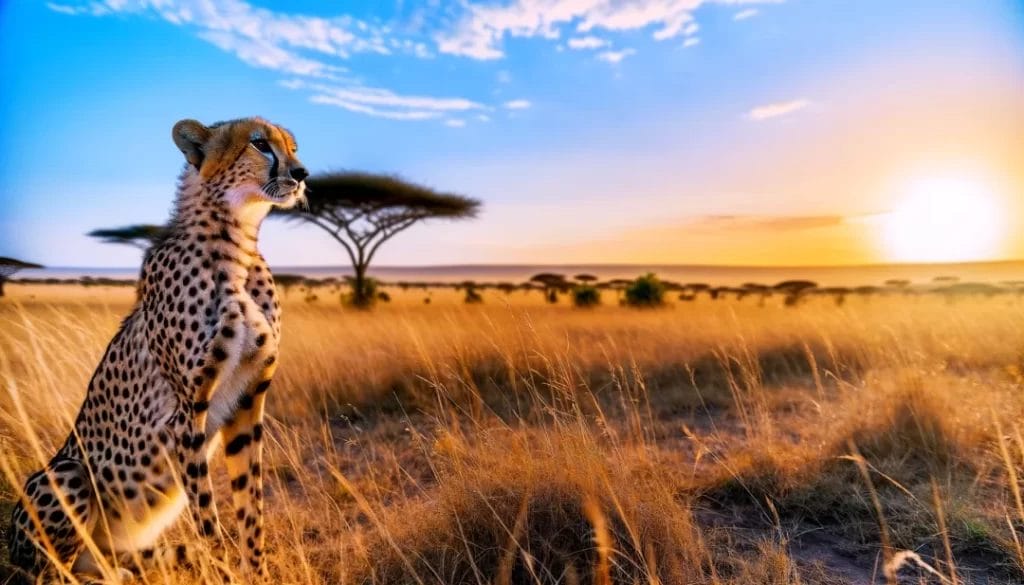The cheetah is a magnificent creature known for its incredible speed and agility. It holds the title of being the fastest land animal in the world, capable of reaching speeds of up to 70 miles per hour in just a few seconds. This remarkable ability has earned the cheetah a reputation as one of nature’s most impressive hunters.
Anatomy of a Cheetah: Understanding the Unique Features that Make Them So Fast
The cheetah’s physical characteristics play a crucial role in its ability to achieve such incredible speeds. It has long, slender legs that provide it with a long stride, allowing it to cover more ground with each step. Its flexible spine acts as a spring, enabling it to stretch and contract its body during high-speed chases. Additionally, the cheetah possesses a lean and muscular body, which helps to reduce drag and increase its overall speed.
The Need for Speed: How Cheetahs Use Their Speed to Survive in the Wild
Speed is essential for the survival of cheetahs in the wild. As predators, they rely on their incredible speed to catch their prey. Cheetahs have excellent eyesight and can spot potential prey from a distance. Once they have identified their target, they use their speed to chase down their prey, often reaching top speeds within seconds. This burst of speed allows them to close the gap between themselves and their prey quickly.
In addition to hunting, cheetahs also use their speed to avoid danger and protect their young. When faced with a threat, such as a larger predator or human encroachment, cheetahs can quickly escape by running at high speeds. This ability to outrun danger is crucial for their survival.
The Hunt: The Cheetah’s Impressive Hunting Techniques
Cheetahs employ a variety of hunting techniques to catch their prey. They are known for their stalking abilities, using their stealth and camouflage to get as close as possible to their target without being detected. Once they are within striking distance, cheetahs rely on their incredible speed to chase down their prey. They can accelerate from 0 to 60 miles per hour in just a few seconds, making it nearly impossible for their prey to escape.
During the chase, cheetahs use their long, muscular tails for balance and maneuverability. They can make sharp turns and sudden changes in direction without losing momentum. This agility allows them to keep up with their prey and make quick adjustments during the chase.
When it comes to taking down larger prey, cheetahs often work together in groups. They coordinate their efforts to surround and bring down the larger animal. This cooperative hunting strategy increases their chances of success and ensures that they can feed themselves and their young.
The Cheetah’s Diet: What Do They Eat and How Much Do They Need to Sustain Their Speed?

Cheetahs primarily feed on small to medium-sized ungulates, such as gazelles and impalas. These animals provide the necessary nutrients and energy for cheetahs to sustain their speed and agility. A single cheetah can consume up to 10 pounds of meat in one sitting, but they do not need to eat every day. Cheetahs have a unique ability to store excess energy in their bodies, allowing them to go without food for several days.
The Cheetah’s Social Life: Understanding Their Family Dynamics and Social Behavior
Cheetahs are generally solitary animals, but they do form social bonds with each other. Male cheetahs often live in small groups called coalitions, usually consisting of brothers from the same litter. These coalitions help males defend their territory and increase their chances of finding a mate.
Female cheetahs, on the other hand, are more solitary and typically raise their young on their own. They establish territories and fiercely protect them from other females and potential threats. Female cheetahs have a gestation period of about 90 to 95 days and give birth to a litter of two to six cubs. The cubs stay with their mother for about 18 months before venturing out on their own.
The Conservation Status of Cheetahs: Why Are They Endangered and What Can We Do to Help?
Despite their incredible speed and agility, cheetahs are currently listed as a vulnerable species by the International Union for Conservation of Nature (IUCN). There are several factors contributing to their declining population, including habitat loss, poaching, and human-wildlife conflict.
Habitat loss is one of the biggest threats to cheetah populations. As human populations expand and encroach upon their natural habitats, cheetahs are losing the open grasslands they rely on for hunting. This loss of habitat forces them into smaller areas, making it more difficult for them to find enough food to sustain themselves.
Poaching is another significant threat to cheetahs. Their beautiful fur and body parts are highly valued in the illegal wildlife trade. Cheetah cubs are also often captured and sold as exotic pets, further contributing to the decline in their population.
To help protect cheetahs, conservation efforts are focused on preserving their natural habitats, raising awareness about the importance of conservation, and implementing measures to reduce human-wildlife conflict. It is crucial that we work together to ensure the survival of these magnificent creatures.
Amazing Facts about Cheetahs: Their Speed, Power, and Agility

Cheetahs are full of fascinating facts that highlight their incredible speed, power, and agility. Here are a few amazing facts about cheetahs:
1. Cheetahs can accelerate from 0 to 60 miles per hour in just a few seconds, making them the fastest land animals in the world.
2. They can maintain their top speed for only a short distance, usually around 1,500 feet, before they need to rest.
3. Cheetahs have a unique stride pattern called “double suspension gallop,” where all four of their feet are off the ground twice during each stride.
4. They have non-retractable claws, which provide them with better traction and grip while running.
5. Cheetahs have a specialized respiratory system that allows them to take in more oxygen during high-speed chases.
6. They have large nasal passages and lungs, enabling them to take in more air with each breath.
Cheetahs in Pop Culture: Their Representation in Art, Literature, and Film
Cheetahs have long captivated the human imagination and have been depicted in various forms of media throughout history. In ancient Egyptian art, cheetahs were often depicted as symbols of royalty and grace. They were associated with the goddess Mafdet, who was believed to protect against venomous snakes and scorpions.
In literature, cheetahs have been featured in numerous works of fiction. One of the most famous examples is Rudyard Kipling’s “The Jungle Book,” where a cheetah named Bagheera is one of the main characters. Bagheera is portrayed as wise and protective, serving as a mentor to the young protagonist, Mowgli.
Cheetahs have also made appearances in various films and documentaries. One notable example is Disney’s “The Lion King,” where the character of Cheetah is portrayed as a loyal and brave friend to Simba.
Celebrating the Majesty and Beauty of the World’s Fastest Land Animal
In conclusion, the cheetah is a truly remarkable creature. Its incredible speed, power, and agility make it one of nature’s most awe-inspiring animals. Understanding the unique features that contribute to its speed, as well as its role as a predator and its social behavior, allows us to appreciate the cheetah even more.
However, it is important to remember that cheetahs are currently facing numerous threats and are listed as a vulnerable species. It is our responsibility to protect these majestic animals and their habitats. By supporting conservation efforts and raising awareness about the importance of preserving biodiversity, we can ensure that future generations will continue to marvel at the beauty and majesty of the world’s fastest land animal.
FAQs
What is a cheetah?
A cheetah is a large, carnivorous mammal that belongs to the Felidae family. It is the fastest land animal and is known for its distinctive spotted coat.
Where do cheetahs live?
Cheetahs are found in various parts of Africa, including eastern and southern Africa. They prefer open grasslands and savannas, but can also be found in other habitats such as scrublands and deserts.
What do cheetahs eat?
Cheetahs are carnivores and primarily feed on small to medium-sized prey such as gazelles, impalas, and springboks. They are also known to occasionally hunt larger prey such as wildebeests and zebras.
How fast can cheetahs run?
Cheetahs are the fastest land animals and can run at speeds of up to 70 miles per hour (112 kilometers per hour) for short distances.
Are cheetahs endangered?
Yes, cheetahs are considered a vulnerable species and are listed as endangered by the International Union for Conservation of Nature (IUCN). Their population has declined significantly due to habitat loss, poaching, and human-wildlife conflict.
How many cheetahs are left in the wild?
It is estimated that there are only around 7,000 cheetahs left in the wild, with the largest population found in Namibia.







